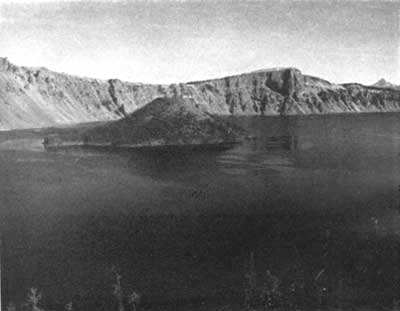MENU
![]() Crater Lake
Crater Lake
|
Glimpses of Our National Parks
THE CRATER LAKE NATIONAL PARK OREGON Special Characteristics: Lake of Outstanding Beauty and Great Depth Cupped in Crater of Extinct Volcano |
 Wizard Island—Crater Lake National Park |
CRATER LAKE is a scenic gem cupped in the crater of an extinct volcano. The volcano, known as Mount Mazama, is in the heart of the Cascade Range, a great chain of volcanic peaks which extends north from the recently active Mount Lassen in northern California through Oregon and Washington and includes Mount Shasta, Mount Hood, Mount Rainier and many other famous glacial-scarred extinct volcanic peaks.
Crater Lake is truly a lake in the top of a mountain. To see it one ascends the gentle slopes of the ancient volcano, slopes mantled by virgin forests and cut by deep canyons. As one ascends the grandeur and depth of the forests, the alpine meadows with their colorful displays of wild flowers, the architecture of the canyons, and the vistas of distant valleys and peaks prepare one for the awe-inspiring beauty of the lake at the top. Coming suddenly on the rim of the vast crater which holds the lake, one stands silent with emotion, deeply impressed by the hues of blue and intensity of color of the water, and by the grandeur of the towering cliffs which completely surround the lake.
Geologists tell us that the rim of Crater Lake is only a remnant of a volcanic peak. Studies indicate that where there is now the vast crater there once was a peak which stood at least 14,000 feet high. Ancient Mount Mazama was comparable to Mount Shasta or Mount Rainier. The many rock formations exposed in the crater wall as well as other features on the rim are evidence that such a peak once existed, and that a great catastrophe occurred during which the peak was destroyed and the crater formed. The most recent investigations led to the conclusion that the crater owes its origin principally to collapse or engulfment of the mountain. Such a catastrophe was undoubtedly preceded by the pouring out of great quantities of lava at the summit of the mountain and the development of cracks on the flanks of the mountain. Eventually the top collapsed and was engulfed within the void produced by the outpourings of ash and molten rock, thus forming the crater.
Following the destruction of the peak, volcanic activity within the deep crater built at least one cone and perhaps others, but none so high as the crater rim. Finally the vast crater cooled. Rain and melted snow of countless ages accumulated, forming the lake with a maximum depth of 2,000 feet. One cone built during the last stages of volcanic activity rises nearly 800 feet above the lake as Wizard Island.
Crater Lake is unique not only for its scenic beauty and scientific interest but also in other respects. The lake has no direct inlet or outlet. Its annual inflow is entirely by precipitation which falls directly into the lake and crater. Annual loss is by seepage and evaporation. From year to year there is essentially no change in lake level. Many visitors are surprised to learn that Crater Lake is a body of fresh water.
ITS MANY ATTRACTIONS
The park embraces 250 square miles of high cascade country, a rugged picturesque area. About 80 percent of the acreage is beautifully forested, principally with mountain hemlock, fir, and pine. During the summer the display of wild flowers typical of high altitudes is most attractive. While the lake is the central attraction, there are numerous other points of interest including canyons, waterfalls, and some vast panoramas obtainable from the tops of park summits; the highest, Mount Scott, is nearly 9,000 feet high The pinnacles, in the canyon of Wheeler Creek near the east entrance, are annually visited by thousands. Wildlife is abundant. There are numerous species of small mammals. Over 100 species of birds may be seen in the park. Black bears and deer are common.
The rim road is unlike anything else in the world, being 35 miles of highway that completely encircles the crater rim, offering incomparable views of the lake and crater, with occasional glimpses of a vast panorama of southern Oregon and northern California. For those who wish to hike there are many miles of trail in the rim area. One of the most popular of the trails is the Crater Wall Trail leading from the rim village to the waters edge. Descending this trail the visitor realizes that in approaching the waters edge the intensity of the color of the water increases, and from the waters edge the visitor gains a magnificent impression of the grandeur of the colorful crater walls towering 500 to 2,000 feet above the water. Throughout the summer launch service is available for trips around the lake and to Wizard Island. There is a trail to the summit of the island. Rowboats are available for visitors wishing to enjoy excellent trout fishing in the crystal clear water of Crater Lake.
 Top
Top
Last Modified: Fri, Sep 1 2000 07:08:48 pm PDT
http://www.cr.nps.gov/history/online_books/glimpses1/glimpses7.htm
![]()

 VII
VII
